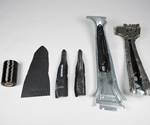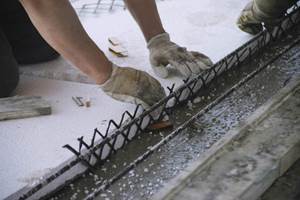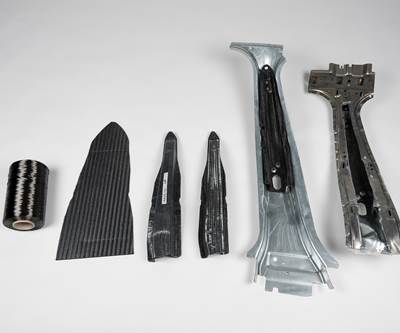IACMI: Driving innovation in the advanced composites industry
Since its start in 2015, the Institute for Advanced Composites Manufacturing Innovation (IACMI) has come a long way in its mission of advancing composites innovation. CTO Uday Vaidya reflects on the past five years.
- Wind/Energy
- Sustainability
- Automotive
- IACMI
- Sheet Molding Compound
- Pultrusion
- Defense
- Carbon Fibers
- Out of Autoclave
- Composites 4.0
- Workforce Development
- Materials
- Glass Fibers
- Fabrics/Preforms
- Pressure Vessels
- Past, Present and Future
- Adhesives
- ATL/AFP
- Processes
- Epoxies
- Resins
- Thermoplastics
- Aerospace
- Reinforcements
- Design & Tooling
- Injection/Overmolding
- Construction
- Hi-Temp Resins
- Compression Molding
- Prepregs
- Nanomaterials
- RTM
- Curing
- Infusion
- Materials Testing
- Filament Winding

IACMI members at CAMX 2019. Source | IACMI
Since its launch in 2015, the Institute for Advanced Composites Manufacturing Innovation (IACMI — The Composites Institute, Knoxville, Tenn., U.S.) has built a network of industry, academic institutions, and federal, state and local governments that are working together to improve the United States’ energy and economic security through composites technology development. This consortium includes more than 160 members in 31 states, more than 130 companies and 17 academic institutes. Launched as the fifth Manufacturing USA Innovation Institute and supported by the U.S. Department of Energy’s Advanced Manufacturing Office, IACMI has proven its capabilities over the past five years to accelerate the development of advanced composites in five technology areas:
- composite materials and processes,
- compressed gas storage (CGS),
- vehicles,
- wind turbines, and
- design, modeling and simulation.
At the Institute’s launch, these areas were identified as those in which more cost-, material- and energy-efficient composite manufacturing could have significant impact. Since then, the composites community within IACMI has grown to support expanding markets such as infrastructure, defense and transportation to enhance U.S. security needs.
In 2016, IACMI led the development of a roadmap to guide the advancement and commercialization of low-cost, energy-efficient composites within the five technology areas. Developed with engagement from industry stakeholders, the roadmap identified promising R&D needed to reduce technology implementation risk and develop a robust supply chain for the advanced composites industry. Specifically, the roadmap outlined more than 200 technology pathways for achieving IACMI’s stated technical goals of 25% reduction in carbon fiber-reinforced polymer (CFRP) cost, 50% reduction in CFRP embodied energy and 80% recyclability or reuse into useful products.
A collaborative innovation network
Over the past five years, the roadmap has provided the catalyst for IACMI and its members to launch collaborative technology demonstration efforts. More than $70 million has been invested in more than 50 industry-led R&D projects, with participation from 90 member companies. These funded projects align with the roadmap’s highest priority activities to both address IACMI member needs and make tangible progress toward its technical targets. As 2020 begins, we reflect on recent project examples across our technology areas.
Composites materials and processes: Fast-curing resins and adhesives can help manufacturers reduce cycle times needed to achieve high-volume production of composite parts. Additionally, products made from recovered discontinuous carbon fibers demand a fraction of the energy needed to produce virgin material with only minor reductions in mechanical properties. Ashland Performance Materials (Columbus, Ohio) and partners demonstrated a novel compression-molded automotive hood inner using diluent-free vinyl ester prepregs that reduced manufacturing cost by 22%, reduced embodied energy by 33%, prolonged shelf life stability, eliminated the need for refrigerated storage, significantly improved the resin-fiber interfacial strength, and enabled recycling and reuse opportunities for prepreg scrap. The American Composites Manufacturers Association (ACMA, Arlington, Va.) and project partners, Continental Structural Plastics (CSP, Auburn Hills, Mich.), CHZ Technologies (Austintown, Ohio), A. Schulman (Fairlawn, Ohio) Oak Ridge National Laboratory (ORNL, Knoxville, Tenn.), are also developing a scalable low-heat pyrolysis method to recover valuable materials from dedicated or mixed stream composite waste.
Modeling and simulation: Modeling and simulation tools help designers predict structural behavior, reduce production steps, optimize design, and manage product testing and prototype development for composite products. IACMI’s own Composite Virtual Factory HUB (cvfHUB) provides members with secure, web-based access to commercial simulation tools for solving design, manufacturing and performance issues of composite materials. DuPont (Troy, Mich.), Fibrtec (Atlanta, Texas), and Purdue University (West Lafayette, Ind.) used predictive modeling tools to demonstrate how Fibrtec’s flexible carbon fiber/polyamide composite tow-preg materials and DuPont’s Rapid Fabric Formation (RFF) processing technology could reduce cost and carbon fiber waste by 30% and embodied energy by 40%.
Vehicles: Fiber-reinforced composites help automakers maximize vehicle mass reduction opportunities, but their implementation is constrained by high costs, long production times, unreliable joinability, low recyclability and an underdeveloped supply chain. Highly automated composite molding technologies for near-net shape composite intermediates can enhance design flexibility while also reducing manufacturing cycle times and waste. Toray Composites (Tacoma, Wash.) partnered with prepreg supply chain experts to develop and optimize a rapid carbon fiber prepreg molding technology that reduces the cost of targeted automotive components by 15%. Meanwhile, Ford (Dearborn, Mich.) with DowAksa (Marietta, Ga.), Dow Chemical (Midland, Mich.), ORNL, Michigan State University (Lansing, Mich.), University of Tennessee (Knoxville, Tenn.) and Purdue University developed a novel epoxy resin system as well as a chopped carbon fiber sheet molding compound (SMC) suitable for high-volume production in excess of 100,000 automotive parts per year.
Compressed gas storage (CGS): Composite materials can help meet the growing demand for compressed natural gas vessels — and eventually, hydrogen storage tanks — as a low-emissions alternative to gasoline and diesel. Thermoplastic-based composite CGS tanks can improve end-of-life recyclability characteristics, while automation strategies can permit low-cost, high-volume production for implementation by automotive manufacturers. DuPont with Steelhead Composites LLC (Goldon, Colo.), Composite Prototyping Center (CPC, Plainview, N.Y.) and the University of Dayton Research Institute (UDRI, Dayton, Ohio) designed a new fabrication process and thermoplastic-based resin system that reduces component weight, improves recyclability, increases damage resistance and lowers production costs by up to 20%.
Wind turbines: While lighter and longer wind turbine blades are needed to increase power generation efficiency and capacity, today’s composite technologies for producing these blades are time-consuming to produce, economically challenging to recycle and increasingly difficult to transport from factory to field. TPI Composites (Scottsdale, Ariz.), Arkema Inc. (King of Prussia, Pa.), Johns Manville (Denver, Colo.), Huntsman Polyurethanes (Auburn Hills, Mich.), Strongwell (Bristol, Va.), DowAksa USA, Chomarat North America (Williamston, S.C.), Composites One (Arlington Heights, Ill.), SikaAxson (now Sika Advanced Resins, Madison Heights, Mich.), Creative Foam (Fenton, Mich.) and Chem-Trend (Howell, Mich.) successfully demonstrated a full-scale 9-meter wind turbine blade and introduced a new vacuum-assisted resin transfer molding (VARTM) process for thermoplastic composites that reduces production costs and improves recyclability compared to thermoset-based composites. In addition, Arkema and partners including Electric Glass Fiber America LLC (Shelby, N.C.), SAERTEX USA LLC (Huntersville, N.C.), General Electric Co. (Boston, Mass.), TPI Composites Inc., University of Tennessee, the National Renewable Energy Laboratory (NREL, Goldon, Colo.) and the Colorado School of Mines (Golden) developed a novel non-adhesive thermal welding method for thermoplastic composites that reduces manufacturing defects compared to adhesive bonding methods and lays the foundation as a potential solution for on-site assembly of longer wind turbine blades.
These and other IACMI collaborative projects are driving commercialization; more than 10 new products are now commercially available because of IACMI collaboration outcomes, and include reduced costs through rapid curing, extended product longevity and efficient manufacturing technologies.
World-class R&D facilities, resources and workforce development
In addition to collaborative projects, one of IACMI’s key differentiators is its production-ready environments for innovation, strategically located throughout the country. For example, IACMI’s Scale-Up Research Facility (SURF), located in Detroit, Mich., offers more than 50,000 square feet of collaboration space, production-scale composites manufacturing equipment and analytical and material preparation spaces. SURF is the nation's only pilot production-scale composite manufacturing facility open to industrial, government, and academic partners.
The Composites Laboratory at University of Dayton Research Institute (UDRI) in Ohio features full-scale manufacturing work cells and small business incubation. UDRI has partnered with more than 20 Ohio-based IACMI members to advance rapid curing prepreg and sheet molding compound materials, vinyl ester resins, additive manufactured tooling for large composites aerostructures, carbon nanotube production technologies and more.
Working in conjunction with NREL’s design, analysis and structural validation capabilities, the Composites Manufacturing and Education Technology Facility (CoMET) provides a 10,000-square-foot facility in Colorado. At CoMET, industry partners and university researchers can design, prototype, test and manufacture megawatt-scale wind turbine blade materials and components, including pultruded carbon fiber spar caps, specialized fiberglass sizings and novel thermoplastic resins.
Finally, in partnership with Purdue University, the Indiana Manufacturing Institute recently opened its new Composites Manufacturing and Simulation Center. The center serves as a testbed for its state partners to take advantage of next-generation Industry 4.0 technologies and develop comprehensive simulation tools for modeling composites structures from manufacturing to end-of-life product cycle.
In addition to conducting R&D, IACMI works to strengthen the advanced composites manufacturing workforce. Since its inception, IACMI has:
- trained more than 2,000 participants in hands-on workshops,
- engaged more than 9,000 K–12 students in STEM activities and opportunities and
- hosted more than 100 interns — 100% of whom have graduated with an industry job offer or graduate program acceptance within six months of graduating from their academic programs.
This column is the first in a series highlighting the work of IACMI and its partners. We at IACMI are committed to the future of advanced composites manufacturing and are actively catalyzing industry efforts to develop a robust supply chain, reduce technical risk for manufacturers and foster the next-generation composites workforce. But our success depends upon the participation of the composites manufacturing community, as well as a continuous stream of projects to feed the pipeline of innovation. Learn more about joining us at iacmi.org.
About the author
Uday Vaidya serves as Director of the University of Tennessee’s Fibers and Composites Manufacturing Facility (FCMF), IACMI’s Chief Technology Officer, and is the University of Tennessee-Oak Ridge National Laboratory Governor’s Chair in Advanced Composites Manufacturing. Vaidya is an expert on the manufacturing and product development with fiber reinforced polymer composites. Vaidya serves as the Editor-in-Chief for Elsevier’s Composites B: Engineering journal. He engages a broad range of undergraduate and graduate students in experiential learning with composites technologies.
Related Content
TU Munich develops cuboidal conformable tanks using carbon fiber composites for increased hydrogen storage
Flat tank enabling standard platform for BEV and FCEV uses thermoplastic and thermoset composites, overwrapped skeleton design in pursuit of 25% more H2 storage.
Read MoreCarbon fiber satellite arm reduces weight, simplifies assembly onto naval vessels
Satcom developer EM Solutions partnered with ACS Australia to replace an aluminum arm design with a 65% lighter, one-piece, corrosion-resistant carbon fiber/epoxy alternative.
Read MoreFrom the CW Archives: Fast-cure epoxies for automotive fabrication
Sara Black’s 2015 report on the development of snap-cure epoxies for automotive manufacturing still resonates today.
Read MoreComposites-reinforced concrete for sustainable data center construction
Metromont’s C-GRID-reinforced insulated precast concrete’s high strength, durability, light weight and ease of installation improve data center performance, construction time and sustainability.
Read MoreRead Next
Carbon fiber/epoxy for automotive mass reduction, mass production
IACMI precompetitive research explores carbon fiber-reinforced prepreg, SMC with novel matrix for structural passenger-car applications.
Read More“Structured air” TPS safeguards composite structures
Powered by an 85% air/15% pure polyimide aerogel, Blueshift’s novel material system protects structures during transient thermal events from -200°C to beyond 2400°C for rockets, battery boxes and more.
Read MoreAll-recycled, needle-punched nonwoven CFRP slashes carbon footprint of Formula 2 seat
Dallara and Tenowo collaborate to produce a race-ready Formula 2 seat using recycled carbon fiber, reducing CO2 emissions by 97.5% compared to virgin materials.
Read More











.jpg;maxWidth=300;quality=90)








